Do you want to learn how to tattoo properly? If so, this comprehensive guide will provide you with all the information you need to get started. In this guide, you will learn about the different types of tattoos, the materials and supplies needed to perform a tattoo, the steps involved in the tattoo process, and safety tips for tattooing. We’ll also discuss the importance of proper aftercare for a successful tattoo. By the end of this guide, you will have all the knowledge necessary to begin your journey as a tattoo artist.
Contents
What is Tattooing?
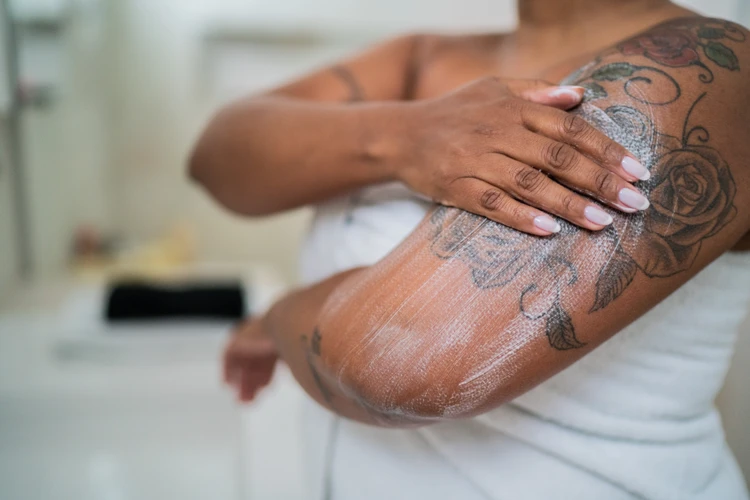
Tattooing is the practice of inserting pigment into the skin to create a permanent design. It is a form of body art that is used to decorate the body with various symbols, patterns, and designs. Tattoos can be used to commemorate important events, to express personal beliefs, or simply to create a unique look. Tattooing has been practiced by cultures around the world for centuries, and it continues to be popular today.
Tattooing is done by using a needle to inject pigment into the skin. The needle is attached to a machine, which is used to control the depth and pressure of the pigment injection. This allows the tattoo artist to create precise and intricate designs. The artist will work with the client to create the desired design, and then use the needle to inject the pigment into the skin. After the tattoo is complete, it is important to keep the tattoo moist while sleeping and during periods of sun exposure.
Choosing the Right Tattoo Design

- Research different tattoo designs, styles and placement options.
- Consider the size and shape of your body and how the tattoo will look on it.
- Look for a tattoo artist who specializes in the style you want.
- Consider the meaning behind the design and how it will affect you in the future.
- Discuss the design and placement with your tattoo artist.
- Make sure to ask questions and get a clear understanding of what the tattoo will look like.
- Be sure to take your time and think carefully before committing to a design.
It’s important to take the time to find the right tattoo design for you. Consider the size and shape of your body and how the design will look on it. Research different tattoo designs, styles and placement options. Look for a tattoo artist who specializes in the style you want. Discuss the design and placement with your tattoo artist and make sure to ask questions and get a clear understanding of what the tattoo will look like. Consider the meaning behind the design and how it will affect you in the future. Be sure to take your time and think carefully before committing to a design.
Choosing a Tattoo Artist
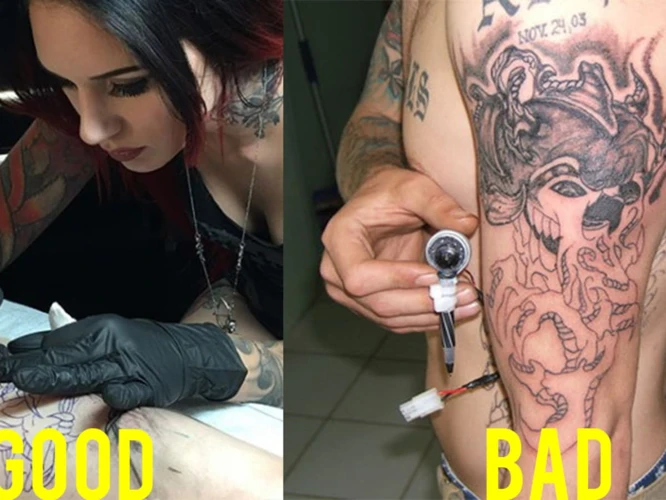
Qualifications:
- Check that the artist has a valid license.
- Make sure they have a portfolio of work.
- Look for reviews online to see what other people have to say about the artist.
- Ask questions about their experience and approach.
Style:
- Identify the style of tattoo you want.
- Find an artist who specializes in the style you’re looking for.
- If you’re unsure about the style, ask the artist for their opinion.
- Ask to see a portfolio of their work.
Safety:
- Ensure that the tattoo artist follows proper safety protocols.
- Check that the artist is using sterile equipment and disposing of needles properly.
- Make sure the artist is wearing gloves and using a fresh set of needles for each customer.
- Look for a good reputation among other tattoo artists.
Preparing for the Tattoo
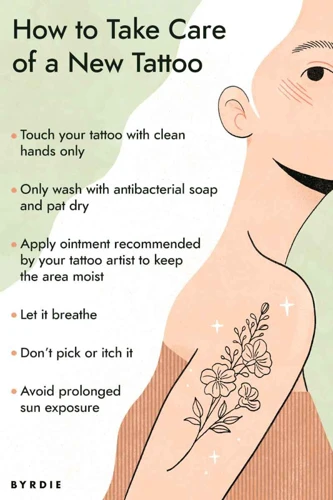
- Choose a Design – Selecting the right design for your tattoo is the most important step in the process. Choose a design that reflects your personality and matches the size of the area you want tattooed.
- Find an Artist – After you’ve chosen your design, it’s important to find an artist who specializes in the style you’re looking for. Look for portfolios, read reviews, and ask around to find the right artist for the job.
- Consult with Your Artist – Schedule a consultation with your chosen artist to discuss your design and make sure they understand the look and feel that you’re hoping to achieve. Make sure to bring any reference material or photographs that may help them understand your vision.
- Test the Ink – Before committing to a tattoo, you should always do a patch test with the ink that will be used. This will help you determine if you’re allergic to the ink and if it will cause any negative reactions.
- Get a Clean Area – A clean area is essential for a successful tattoo. Make sure that the area you’re getting tattooed is clean and free from any dirt or debris. If possible, shave the area to ensure that the skin is smooth and free of hair.
- Gather Supplies – Before you start the tattooing process, make sure you have all the necessary supplies on hand. This includes a tattoo machine, needles, ink, sterilized gloves, and other equipment.
- Get Ready – Make sure that you’re relaxed and comfortable before you start the process. Take deep breaths and focus on your breathing to help you stay calm.
Applying the Tattoo
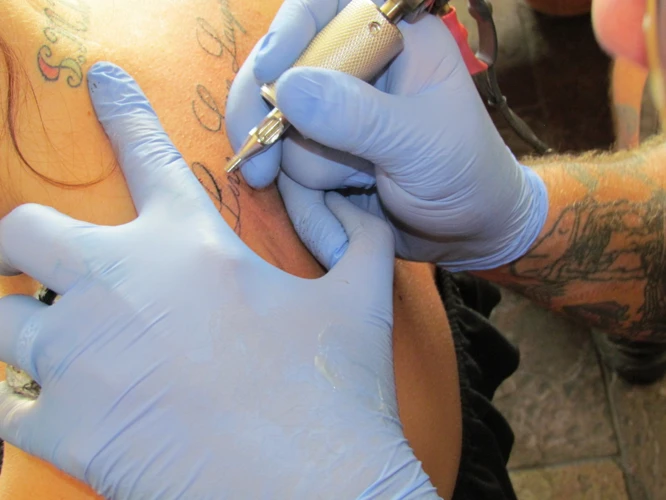
Step 1: Prepare the Skin
- Wash the area to be tattooed with a mild soap and hot water.
- Shave the area if necessary.
- Use rubbing alcohol to clean the area once more.
Step 2: Set Up the Tattoo Gun
- Assemble the tattoo gun according to the manufacturer’s instructions.
- Fill the tattoo needle with ink.
- Test the gun by pressing down on the foot pedal.
Step 3: Begin Tattooing
- Position the needle on the skin at the desired location.
- Press down on the foot pedal to begin the tattooing process.
- Move the needle in a steady, even motion to deposit the ink into the skin.
- Change the needle depth and speed as needed.
Step 4: Clean the Area
- Gently wipe away any excess ink with a dry cloth.
- Clean the area with a cloth soaked in rubbing alcohol.
- Apply a thin layer of antibiotic ointment to the area.
Step 5: Care for the Tattoo
| Activity | Instructions |
|---|---|
| Cleaning | Gently wash the tattoo with antibacterial soap and pat dry with a clean towel. |
| Moisturizing | Apply a thin layer of fragrance-free lotion to the area. |
| Protecting | Cover the tattoo with a bandage until it is healed. |
Aftercare Instructions
| What to do | What not to do |
|---|---|
| Clean the area with a mild antibacterial soap and warm water. | Do not use alcohol, peroxide, or iodine. |
| Pat the area dry with a clean towel. | Do not rub the area. |
| Apply a thin layer of aftercare balm or cream. | Do not apply thick layers as it can trap bacteria. |
| Keep the area clean and moisturized. | Do not swim, soak, or expose the area to direct sunlight. |
How to Keep Tattoo Moist While Sleeping
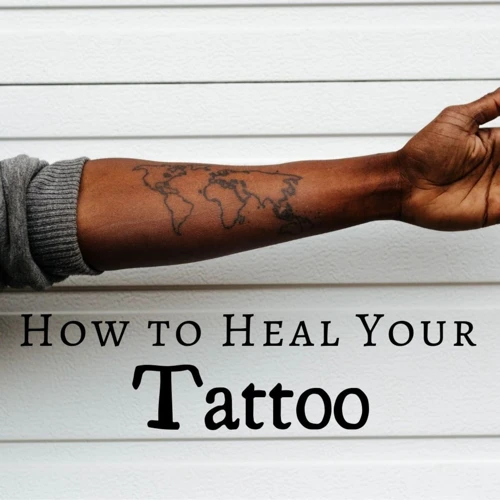
- Clean the tattoo before sleeping: Before going to bed, it is important to clean the tattoo with warm water and a mild soap. This will help to remove any dirt, oil, and sweat that may have accumulated during the day.
- Apply a thin layer of petroleum jelly: After cleaning and drying the tattoo, it is important to apply a thin layer of petroleum jelly to the tattoo. This will help to keep the tattoo moist and prevent it from drying out.
- Cover the tattoo with a bandage: After applying the petroleum jelly, it is important to cover the tattoo with a bandage. This will help to keep the tattoo from rubbing against the sheets while sleeping.
- Wear loose-fitting sleepwear: It is important to wear loose-fitting sleepwear when sleeping to avoid any friction against the tattoo. This will help to reduce any discomfort or pain while sleeping.
- Keep the tattoo moisturized: It is also important to keep the tattoo moisturized during the day. This can be done by applying a thin layer of petroleum jelly or a moisturizing lotion throughout the day.
Preventing Infection and Complications
- Cleanliness: Wash your hands and the area where you plan to tattoo with an antiseptic soap and warm water before beginning. Wear sterile, disposable gloves and use a sterile, disposable paper towel to dry the area.
- Protective gear: Wear protective eyewear and a face mask while tattooing to protect yourself from contaminants and potential infections.
- Equipment and ink: Make sure to use sterile, single-use needles and ink for each tattoo session. Store your ink and needles in airtight containers and avoid reusing needles.
- Aftercare: Keep your tattoo clean and moist. Clean it with mild soap and warm water twice a day and apply a thin layer of ointment or lotion. Avoid swimming, soaking in a hot tub, and direct sun exposure while your tattoo is healing.
- Signs of infection: Watch for signs of infection such as redness, swelling, and pus. If you experience any of these symptoms, seek medical attention immediately.
Frequently Asked Questions
What Supplies Are Needed to Safely Tattoo Someone?
Gloves: Sterile, disposable gloves are a must for any tattoo artist to prevent the spread of germs and infections.
Needles: Quality, sterile needles are necessary to ensure a safe and successful tattoo.
Tattoo Machine: A professional-grade tattoo machine is crucial for delivering the desired results.
Inks: Quality inks are essential for creating a vibrant, long-lasting tattoo.
Grips and Tips: Grips and tips should be autoclaved or disposed of after every use to ensure safety.
Barrier Film: Barrier film is a must to protect both the tattoo artist and the client.
Antiseptic Solution: An antiseptic solution should always be used to clean the skin before and after the tattooing process.
How do I know what type of needle to use?
Size: The size of the needle depends on the size of the tattoo. A larger tattoo will require a larger needle, while a smaller tattoo will require a smaller needle.
Shape: Needles come in many shapes, including round, flat, magnum, and curved. Each shape will produce a different effect, so it is important to determine which type of needle is best suited for the particular tattoo.
Number: The number of needles used will depend on the size of the tattoo. Generally, a larger tattoo will require more needles than a smaller one.
Gauge: The gauge of the needle is also important. The thicker the needle, the more ink it will hold. This will result in a thicker, more solid line.
- Choose the size of the needle depending on the size of the tattoo.
- Choose the shape of the needle depending on the desired effect.
- Choose the number of needles depending on the size of the tattoo.
- Choose the gauge of the needle depending on the desired thickness of the lines.
What Steps Should I Take to Properly Clean and Sterilize My Equipment?
1. Disassemble the Equipment
- Take apart all equipment components, including tubes, needles, and any other parts.
- Clean each part separately.
2. Clean the Equipment
- Clean all parts of the equipment using a mild detergent and water.
- Rinse the equipment with clean water.
- Dry the equipment with a lint-free cloth.
3. Sterilize the Equipment
- Place the equipment in an autoclave and sterilize according to manufacturer’s instructions.
- Allow the equipment to cool before use.
4. Store the Equipment
- Place the equipment in a clean, dry container.
- Store the container in a cool, dry place.
What Aftercare Instructions Should I Provide to My Clients?
Advise clients to avoid submerging the tattoo in water: To ensure the best results, tell clients to avoid submerging the tattoo area in water for the first two weeks. This includes swimming and taking baths.
Ensure the area is kept clean: Instruct the client to clean the tattooed area twice daily with mild soap and warm water. The skin should be gently patted dry with a soft clean cloth or paper towel.
Instruct the client to apply a thin layer of healing ointment: For the first two weeks, advise the client to apply a thin layer of healing ointment to the tattooed area twice daily.
Advise clients to keep the tattoo covered: To protect the tattooed area, instruct the client to keep it covered with clothing or a bandage for the first two days following the procedure.
Instruct clients to avoid direct sun exposure: Advise clients to avoid direct sun exposure and tanning for at least four weeks. This will help ensure the best results.
How can I minimize skin irritation and minimize the risk of infection?
- Follow instructions provided by the tattoo artist. This includes instructions on how to take care of the tattooed area during the healing process and how to prevent infections.
- Clean the skin before the tattoo is done. Wash the area with mild soap and warm water and pat dry.
- Use a sterile needle and a fresh batch of ink for each tattoo. This will reduce the risk of infection.
- Avoid sun exposure to the tattooed area while it is healing. Sunlight can cause irritation and increase the risk of infection.
- Keep the area clean and dry. Clean the area gently with mild soap and warm water and pat dry. Do not use harsh soaps or harsh scrubbing.
- Apply a thin layer of moisturizer to the area after showering or bathing. This will help keep the skin hydrated and reduce irritation.
- Avoid scratching, picking, or rubbing the area. This can lead to an infection and can cause irritation.
- Avoid swimming or soaking in hot tubs while the tattoo is healing. This can increase the risk of infection.
- See a doctor if the area becomes red, swollen, or painful. This could be a sign of an infection and should be treated immediately.
Conclusion
Tattooing is an art form that requires skill, attention to detail, and a thorough understanding of the risks involved. When done properly, tattoos can be beautiful and meaningful pieces of art. To ensure a safe and successful tattoo, it is important to do your research, ask questions, and work with a reputable, experienced artist. With the right preparation and care, you can get the perfect tattoo and enjoy it for years to come.